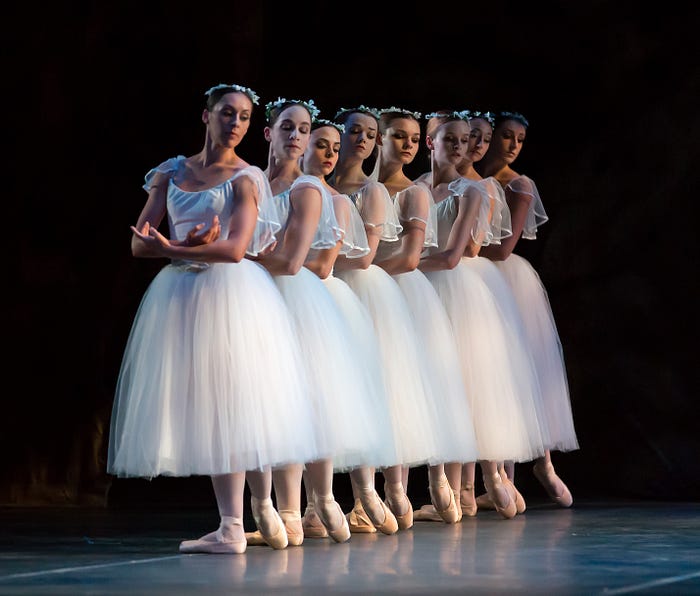GISELLE will give you the Wilis
By Eva Kahn
Have you ever gotten the willies?
You know, those knots in your stomach, a tingling on the back of your neck, goosebumps on your goosebumps? A case of the “willies” is a general queasiness or foreboding: an “I’ve got a bad feeling about this” kind of moment. We’ve all been scared at one point or another, but what exactly are the “willies” and where do they come from?
The Wilis, a sisterhood of supernatural Rockettes from the classic Romantic Era ballet GISELLE, are the spirits of women jilted at the altar on their wedding day. They roam the forests, and as spiritual revenge, they force men to dance until they die of exhaustion. In Giselle, the Wilis evoke awe and terror from men in the story and audience members alike. Yet, no one is quite sure if the Wilis were the origins of the phrase to “give you the willies,” or if that language developed separately from other anecdotes, wives’ tales or phenomena having nothing to do with the 19th-century ballet. To dig deeper into this word puzzle, let’s examine “willie lore” from two continents.

European ‘Willis’
For starters, we should brush up on our Slavic mythology. The Serbo-Croatian word “vila” refers to a wood-nymph, ghost, or fairy-like creature that is actually the spirit of a woman who has died unbaptized or unbetrothed. These women, trapped between this world and the next, cannot rest in their graves due to a love of dance they were unable to appease during their lives. Unlike fairies, who are born as spirits of nature, the “wila” only become spirits after death and are known for their intense ferocity toward mortal men.
In 1835, Heinrich Heine, a German journalist, published an article in the French Revue des deux Mondes about the Slavic “Willis.” Inspired by the article, the choreographers Jules Perrot and Jean Corelli, along with other writers, dancers, and composers, created the first version of the ballet Giselle, which premiered in Paris in 1841.

Shortly thereafter in 1852, the French novelist Jean-Baptiste Alphonse Karr wrote a short story, Les Wilis, that became the basis for Giacomo Puccini’s opera, Le Villi, premiering in Italy in 1884. Though these wood-nymphs seemed to have become a pop-culture phenomenon, did they truly give people the “willies?”
American ‘Woolies,’ ‘Willeys’ and ‘Willies’
Early American frontiersmen wore long woolen underwear. These undergarments gave them the “woolies,” a case of itchy, irritable skin. This regional term came to refer to a “case of nervousness” as well. Also during that time period, the insult “willie-boy” was used in the same way “sissy” is today.
In 1826, the Willey House tragedy occurred. The Willey family lived in Crawford Notch, a landslide-prone region in the White Mountains of New Hampshire. During August of that year, after a long, dry summer, a terrific rainstorm caused a landslide near the Willey’s home. The family escaped to a stone shelter they had built nearby for safety, but the shelter collapsed into the mud. The bodies of Mr. and Mrs. Willey, their two hired hands, and their two daughters were found. But the bodies of their three other children remain missing to this day.

It was said that if you wander through the woods in that area at night, you can catch the “willies” — a sighting of the three lost children.
If not the ghosts of predatory women or lost children, what about baseball? Willie Mays and Willie McCovey played their golden years for the San Francisco Giants between 1959 and 1972. As batters, they were so feared by opposing teams, they were said to give pitchers the “The Willies” when they stepped up to the plate.

Got the willies yet? If not, catch a glimpse of the balletic version of these spectral beauties this Mother’s Day weekend with Ballet Austin and GISELLE! Four shows only, May 10–12 at the Long Center. For tickets and show information, visit https://balletaustin.org/performances/giselle2019
SOURCES
Ancient Origins, “Beware the Wandering Wilas”: https://www.ancient-origins.net/myths-legends-europe/beware-wandering-wilas-002273
How Stuff Works, “Where did the idea of ‘the willies’ come from?”: https://people.howstuffworks.com/the-willies.htm
National Baseball Hall of Fame, “WILLIE MCCOVEY”: https://baseballhall.org/hall-of-famers/mccovey-willie
New England Historical Society, “The Willey Family Tragedy and a Painting Create White Mountain Tourism”: http://www.newenglandhistoricalsociety.com/the-willey-family-tragedy-and-a-painting-create-white-mountain-tourism/
The Phrase Finder, “Scared the Willies”: https://www.phrases.org.uk/bulletin_board/5/messages/132.html
The Word Detective, “Willies”: http://www.word-detective.com/2009/10/willies-the/
WQXR: New York Public Radio, “When Puccini Got the Willies”: https://www.wqxr.org/story/227652-when-puccini-got-willies/
